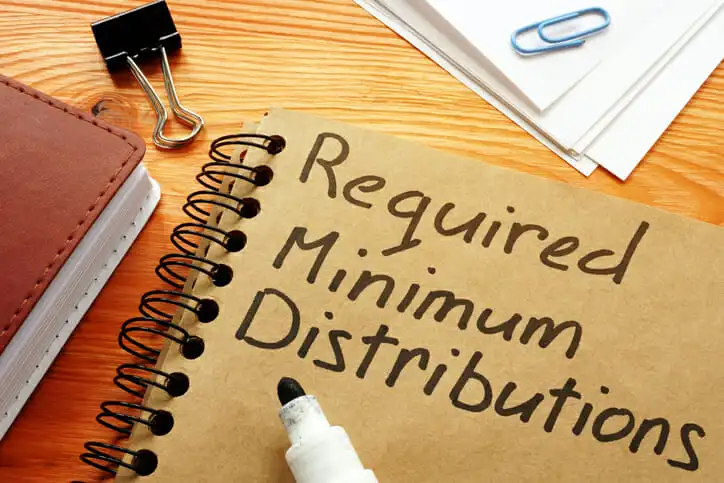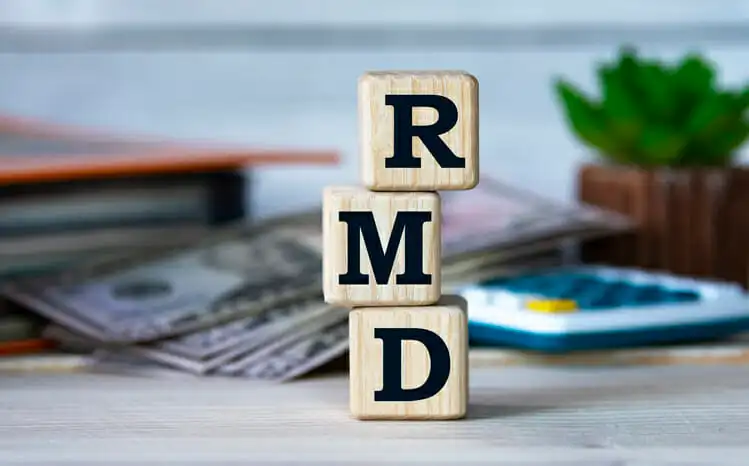Individual retirement accounts (IRAs), 401(k)s and other workplace plans can help you build wealth for the future while enjoying some tax benefits. However, once you retire, you’ll need to account for required minimum distributions (RMDs). The IRS requires you to begin taking distributions from certain retirement accounts, but applying these RMD strategies can potentially help you reduce distributions and better manage your tax bill.
A financial advisor can help you create a financial plan to manage your taxes in retirement. Speak with a financial advisor today.
All About Required Minimum Distributions
Required minimum distributions (RMDs) are amounts you’re obligated to withdraw from certain tax-advantaged retirement plans. The types of accounts that are subject to RMDs include:
- Traditional IRAs
- SEP IRAs
- SIMPLE IRAs
- 401(k) plans
- 403(b) plans
- 457(b) plans
- Profit-sharing plans
- Other defined contribution plans
However, Roth IRAs don’t have RMDs, allowing you to leave your money in these accounts as long as you want. (Roth 401(k)s also are not subject to RMDs,) Anyone who inherits your Roth account, however, will have to take minimum distributions.
For anyone yet to take RMDs, they generally begin at age 73 (75 for people born in 1960 or later). More specifically, the IRS says you must start taking them by your required beginning date.
Your first RMD is due April 1 of the year following the year in which you turn 73. So if you turn 73 on Oct. 5, then your RMDs must be taken by April 1 of the following calendar year. The deadline for all subsequent RMDs is December 31 each year.
The amount you must withdraw depends on your account balance and a life expectancy factor set by the IRS. Withdrawals are taxed at your ordinary income tax rate.
However, if you miss your RMD deadline, you may face a 25% penalty on the amount you failed to withdraw (10% if you correct the RMD within two years).
RMD Strategies to Reduce Taxes

Taking RMDs can create tax challenges, especially if you’ve accumulated substantial balances in your IRAs or workplace retirement accounts. Large RMDs can push you into a higher tax bracket, increasing your overall tax liability. That’s why it’s important to consider these RMD strategies to help minimize the tax impact and preserve more of your retirement income.
1. Draw Down Your Account Early
Once you turn 59 ½, you can begin making withdrawals from retirement accounts without a tax penalty. Taking larger distributions in the early years of retirement can reduce your overall account balance, thus lowering your RMDs later on. This option may be advantageous if you anticipate falling in a lower tax bracket upon retirement.
Drawing down your retirement accounts before age 73 can offer another benefit: you may be able to delay Social Security benefits. The longer you delay benefits beyond your full retirement age, the more your benefit amount increases. If you can wait until age 70, for example, you’ll receive 132% of your benefit amount.
2. Consider a Roth IRA Conversion
Roth IRAs offer the benefit of 100% tax-free qualified withdrawals without RMDs. If you want to avoid required distributions altogether, you can convert your traditional retirement funds to a Roth account.
However, you will have to pay tax on the conversion in the year it occurs, possibly leaving you with a hefty tax bill. Depending on your situation, it may be worth it to take a one-time tax hit in order to avoid RMDs and withdraw retirement funds tax-free. This is where a financial advisor can help you weigh your options.
3. Work Longer
If you have some of your retirement funds in your current employer’s 401(k), you might consider working longer to avoid RMDs. As long as you’re still working in some capacity, you’re not required to take minimum distributions from your current employer’s plan.
That exception doesn’t apply to retirement accounts you had with previous employers. You won’t get a pass on IRA RMDs, but continuing to work could help to reduce the total amount of mandatory RMDs once you turn 73. And again, you can also delay Social Security benefits.
Use our RMD Calculator to estimate how much you’ll need to withdraw from your retirement accounts each year.
Required Minimum Distribution (RMD) Calculator
Estimate your next RMD using your age, balance and expected returns.
RMD Amount for IRA(s)
RMD Amount for 401(k) #1
RMD Amount for 401(k) #2
About This Calculator
This calculator estimates RMDs by dividing the user's prior year's Dec. 31 account balance by the IRS Distribution Period based on their age. Users can enter their birth year, prior-year balances and an expected annual return to estimate the timing and amount of future RMDs.
For IRAs (excluding Roth IRAs), users may combine balances and take the total RMD from one or more accounts. For 401(k)s and similar workplace plans*, RMDs must be calculated and taken separately from each account, so balances should be entered individually.
*The IRS allows those with multiple 403(b) accounts to aggregate their balances and split their RMDs across these accounts.
Assumptions
This calculator assumes users have an RMD age of either 73 or 75. Users born between 1951 and 1959 are required to take their first RMD by April 1 of the year following their 73rd birthday. Users born in 1960 and later must take their first RMD by April 1 of the year following their 75th birthday.
This calculator uses the IRS Uniform Lifetime Table to estimate RMDs. This table generally applies to account owners age 73 or older whose spouse is either less than 10 years younger or not their sole primary beneficiary.
However, if a user's spouse is more than 10 years younger and is their sole primary beneficiary, the IRS Joint and Last Survivor Expectancy Table must be used instead. Likewise, if the user is the beneficiary of an inherited IRA or retirement account, RMDs must be calculated using the IRS Single Life Expectancy Table. In these cases, users will need to calculate their RMD manually or consult a finance professional.
For users already required to take an RMD for the current year, the calculator uses their account balance as of December 31 of the previous year to compute the RMD. For users who haven't yet reached RMD age, the calculator applies their expected annual rate of return to that same prior-year-end balance to project future balances, which are then used to estimate RMDs.
This RMD calculator uses the IRS Uniform Lifetime Table, but certain users may need to use a different IRS table depending on their beneficiary designation or marital status. It's the user's responsibility to confirm which table applies to their situation, and tables may be subject to change.
Actual results may vary based on individual circumstances, future account performance and changes in tax laws or IRS regulations. Estimates provided by this calculator do not guarantee future distribution amounts or account balances. Past performance is not indicative of future results.
SmartAsset.com does not provide legal, tax, accounting or financial advice (except for referring users to third-party advisers registered or chartered as fiduciaries ("Adviser(s)") with a regulatory body in the United States). Articles, opinions and tools are for general informational purposes only and are not intended to provide specific advice or recommendations for any individual. Users should consult their accountant, tax advisor or legal professional to address their particular situation.
4. Donate to Charity
One of the most popular strategies for avoiding taxes on RMDs involves making qualified charitable distribution (QCD). The IRS allows you to donate up to $108,000 from an IRA in 2025 without having to pay income tax. The money you withdraw will still count toward your RMD, so you don’t have to worry about a 25% tax penalty for failing to take distributions.
However, a few rules apply:
- You can only donate up to $108,000 to a qualified charity.
- Your IRA custodian must arrange for the transfer of funds to an eligible charity.
- You may not claim the donation as a charitable deduction on your taxes.
You might consider this option if you don’t necessarily need all of the funds in your IRA and you want to support a good cause in retirement.
5. Consider a Qualified Longevity Annuity Contract
A qualified longevity annuity contract (QLAC) is a type of deferred annuity contract. You can use your retirement funds to buy the annuity and then receive payments back at a later date. Payments are required beginning at age 85, and any money you put into the annuity does not factor into your RMD calculations.
Still, you can only invest a certain amount of money into a QLAC. For 2025, you can contribute a maximum of $210,000.
However, while you can use a QLAC to defer taking RMDs until age 85, you can’t avoid them indefinitely.
6. Check Your Beneficiaries
If you’re married and there’s a sizable age gap between you and your spouse, you might have another option for reducing RMDs. When you’re 10 or more years older than your spouse and name them as the sole beneficiary of your retirement account, you can use the IRS Joint Life and Last Survivor Expectancy Table to calculate RMDs. There is also an available worksheet on the IRS website.
This strategy allows you to use your spouse’s longer life expectancy to determine how much to withdraw, potentially reducing the amount. Of course, if your spouse is closer to your own age or you have multiple beneficiaries, you wouldn’t be able to use this RMD strategy.
Bottom Line

Applying RMD strategies can be a straightforward way to minimize your tax liability during retirement. You can use just one strategy or apply several in order to lower your tax bill. Just remember that, with the exception of a Roth IRA conversion, there’s no way to avoid RMDs indefinitely.
Retirement Planning Tips
- Consider talking to a financial advisor about different RMD strategies. Finding a financial advisor doesn’t have to be hard. SmartAsset’s free tool matches you with vetted financial advisors who serve your area. You can have a free introductory call with your advisor matches to decide which one you feel is right for you. If you’re ready to find an advisor who can help you achieve your financial goals, get started now.
- A backdoor Roth IRA is also something to consider if your income is too high to contribute to a Roth account directly. The IRS limits who can contribute to a Roth IRA based on filing status and modified adjusted gross income. But you can convert traditional retirement account funds to a Roth account. Again, you will have to pay taxes on the conversion at the time it’s completed but you might consider this option if you expect to be in a higher tax bracket when you retire.
Photo credit: ©iStock.com/Zhanna Hapanovich, ©iStock.com/Seiya Tabuchi, ©iStock.com/designer491
